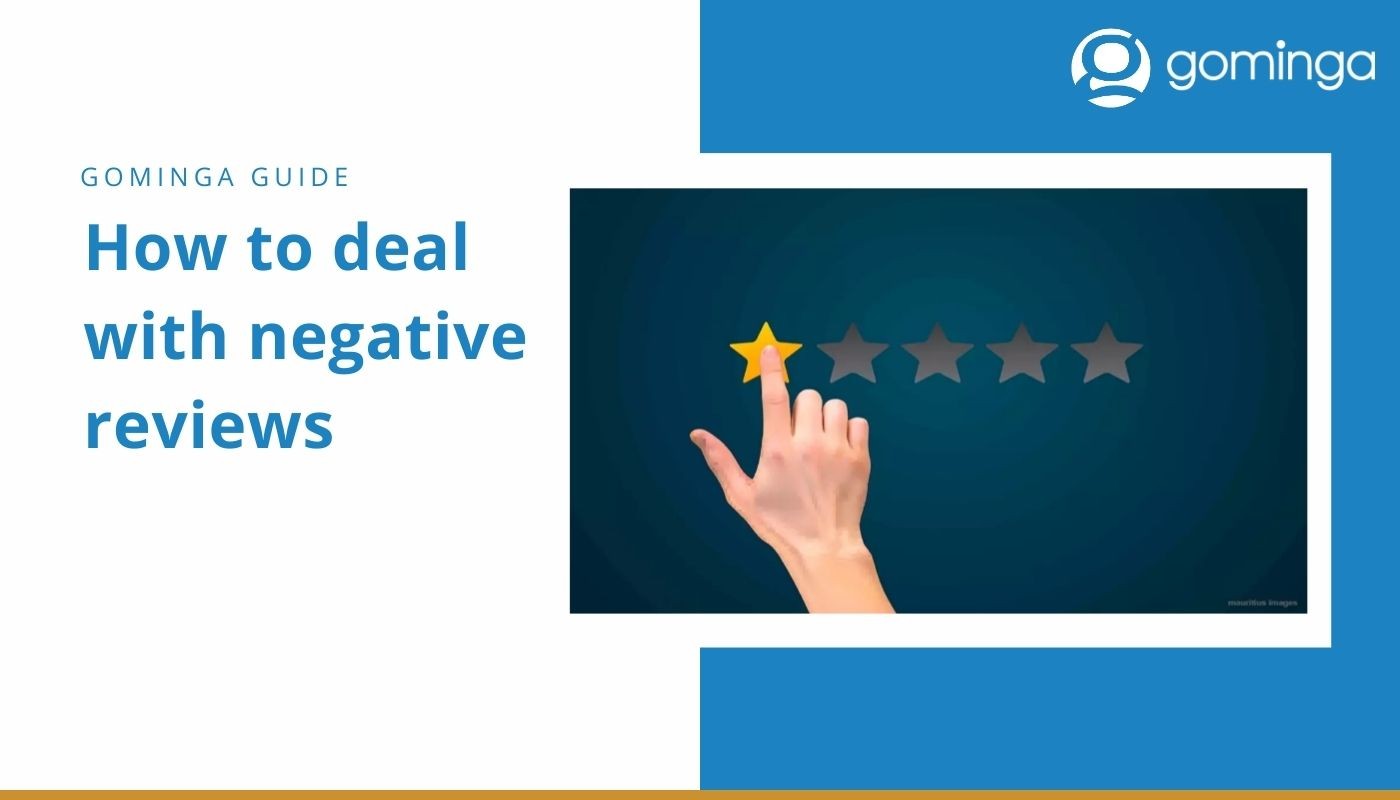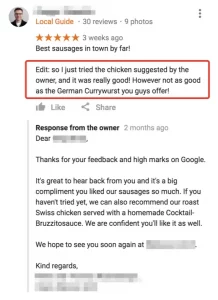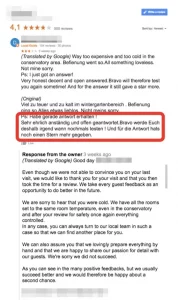
No one likes negative reviews or criticism. People may often react defensively to them. They try to avoid the situation, work around it, or explain themselves. This is a natural reaction, but it is the wrong way to act in the corporate world. All customer reviews are important for the success of a company’s business. According to the Customer Journey Study 2021, customer reviews come first during the information phase for customers within the customer journey! Negative reviews are also crucial and represent a special opportunity for the company!
As a business owner, it’s essential to know how to deal with negative reviews effectively to maintain a positive online reputation. When responding to a negative review, acknowledge the customer’s unhappy experience and show empathy. Offer a sincere apology and take responsibility for any shortcomings on your part. Propose a solution to address their concerns and invite them to discuss the issue further offline. Keep in mind that potential customers may be reading your review responses. Demonstrate professionalism and a commitment to customer satisfaction. Avoid getting defensive or argumentative, as this can worsen the situation and drive customers away, thus having a negative impact on your business.
Negative reviews can also provide valuable insights into areas where your business needs improvement. Analyze the feedback and look for patterns. Use this information to make necessary changes and prevent similar negative experiences in the future. Encourage satisfied customers to leave positive reviews to balance out any negative ones. Actively seek feedback and show appreciation for all positive and negative reviews. By proactively monitoring your online reputation and handling negative reviews gracefully and professionally, you can turn a potentially damaging situation into an opportunity to showcase your dedication to customer service and continuous improvement.
The article discusses the importance of negative reviews for businesses and offers guidelines on handling them effectively to demonstrate a commitment to customer satisfaction. It includes examples of successful responses to negative reviews that can turn a negative experience into a positive one and boost customer loyalty.
Negative Reviews are Important
Criticism is completely normal. Top ratings are subject to a certain amount of scepticism. It simply seems untrustworthy when a product is completely perfect. Of course, a negative rating can scare off potential customers. Nevertheless, negative comments should be seen in a different light.
Negative online reviews represent an outstanding opportunity: Companies can show their personality and empathy. Show that problems are taken seriously and can be solved. That customer proximity and customer satisfaction come first. Responding to reviews like these gives the company a face and makes it more human.
It’s essential to understand that negative reviews can have a significant impact on your business in the long run. A single bad customer review can cause potential customers to question the quality of your products or services and may even deter them from engaging with your brand altogether. However, by responding to negative reviews in a constructive and professional manner, you can mitigate the damage and even turn the situation around.
When crafting a response to a negative review, it’s crucial to put yourself in the shoes of the negative reviewer. Try to understand their perspective and the root cause of their dissatisfaction. By showing empathy and a genuine desire to resolve the issue, you demonstrate to both the reviewer and potential customers reading the exchange that you value customer feedback and are committed to providing excellent service.
Dealing with Negative Reviews Online – Learn How to Respond
The response to negative feedback happens mostly online. This means customers see and follow how companies deal with negative reviews. Companies thus represent the quality of the customer experience to the public! This also has an impact on the business’s reputation. Reputation management should be known to every company. It would be a public failure if it is not done properly. Thus, properly responding to positive as well as negative reviews should be a priority. A full 96% of consumers read businesses’ responses to their reviews (Bright Local Review Study 2020). It becomes clear – proper handling of reviews, especially negative feedback, is required!
Dealing with negative reviews is not easy. The company is faced with a major challenge. General guidelines have been compiled below to keep in mind when responding to customer reviews.
Recognize it
Try not to hide from your bad reviews. Likewise, it is not helpful to ignore or even delete negative reviews.
The most important thing at this point is to read the review. Try to understand what exactly happened. Still, look at the review objectively and not personally. Try to see the unhappy customers perspective and understand their problem. Take the time to respond. Show the customer that you take the problem seriously.
Respond to the review in a factual and polite manner. Please avoid generic responses at this point. These do not seem personal and do not offer the customer a solution.
Show gratitude
You should be grateful for any kind of feedback – both positive and negative reviews. After all, it is honest customer feedback. Negative reviews can help highlight errors or weaknesses in a particular area within the company. Thus, a “thank you for the feedback” is an important part of a well-formulated response to customer complaints.
Show responsibility
Everyone makes mistakes. But that also includes standing behind those mistakes. Apologize. This works wonders. 37% of angry customers are satisfied when companies offer compensation. 74% of customers show satisfaction once not only compensation is offered, but an apology follows (The Customer Rage Study 2015). It is not enough to simply apologize. The apology should be sincere, emphatic as well as specific. It is also important that you justify the apology. Only then can it be understood and accepted by the customer.
Of course, there are exceptions. You should not apologize if you have done nothing wrong. Nevertheless, show understanding. Make it clear that the reason for dissatisfaction does not depend on you.
Be quick
We live in a fast-paced world. Customers also want quick feedback on reviews. 61% of customers expect a response within the first three days (Bright Local Review Study 2020). Long, unanswered negative reviews can deter potential customers.
“Of course, nobody wants a robot answer. But you can support many questions on the system side and thus increase the speed.”
— Miriam Aust, Project Manager for Digital Projects, Digital Services and E-commerce Support, Samsung
Focus on one area of improvement.
Negative customer reviews are valuable pieces of information. Go through your negative reviews and gather insights and suggestions for improvement.
Mention your findings in your responses! This shows that you understand the problem and are willing to work on it.
Implement your suggestions for improvement. It is best to start with an improvement that can be solved relatively easily and quickly. This way, you show customers that you can accept negative criticism and respond to it immediately. While you are implementing quicker improvements directly, you can work internally on larger changes.
Keep in touch with your customers
After you have successfully responded to a negative review and provided a solution, don’t lose sight of the customer! After a few weeks, write the customer again and ask if they are satisfied with your solution. For many customers, this is a positive surprise! This not only generates customer enthusiasm, but can also lead that the customer formulate positive feedback and citing you as a good example of how to react correctly to negative customer feedback.
These are just a few examples on how you can properly handle negative customer reviews. Basically, you can see the need to respond to every negative review! To ensure that all customers are heard it is important for companies to closely monitor the reviews on all review sites and respond to as many as possible. This can be ensured with the help of our review management software!
Best examples of how to respond to negative reviews on Google
In the following section, we will take a look at a few examples of how businesses have successfully responded to Google reviews. These examples will provide valuable insights into the best practices for handling negative feedback and turning dissatisfied customers into loyal advocates for your brand.
1. Upselling: invite your guest with a specific purpose
 In this example, guests were happy with their experience and posted positive reviews of the restaurants they visited. Nevertheless, you can react similarly in case of negative feedback.
In this example, guests were happy with their experience and posted positive reviews of the restaurants they visited. Nevertheless, you can react similarly in case of negative feedback.
The owners didn’t only thank the guests for their feedback but also invited them to come back and do something they haven’t done yet. After reading the management response, the guest came back to try a roast chicken which was suggested by the owner. He then updated his previous review with new feedback.
This example clearly shows how easy it is to strengthen customer loyalty and engagement by responding properly to reviews.
2. Asking for more details and taking the conversation off the platform
 The review below was originally posted with a one-star rating and no text. The owner asked the guest for some more details about her visit to be able to improve in the future. He also provided his contact information to which the guest could get in touch directly to discuss the issue.
The review below was originally posted with a one-star rating and no text. The owner asked the guest for some more details about her visit to be able to improve in the future. He also provided his contact information to which the guest could get in touch directly to discuss the issue.
It turned out that she left a one-star rating by mistake. She liked the owner’s response, and since the overall experience at the restaurant was positive, she updated the review with a top rating.
This raise from one to five stars can be very significant in Google’s rating and make a difference when guests decide whether or not to visit a restaurant.
3. Explaining the situation and winning your guest’s trust
 In the next example for responses to online reviews, a guest complained about the room temperature. The restaurant’s team apologized and tried to provide a solution. The restaurant didn’t try to push back but was very diplomatic and understanding. The response is personal and friendly.
In the next example for responses to online reviews, a guest complained about the room temperature. The restaurant’s team apologized and tried to provide a solution. The restaurant didn’t try to push back but was very diplomatic and understanding. The response is personal and friendly.
Also, in this case, the guest updated the review: he was excited to receive a response to his criticism and gave one star more. This example shows that a professionally written management response can turn bad experiences into good ones. The guest’s impression of the restaurant changed and he even would like to come back.
Of course, the goal of a restaurant should be to provide outstanding customer experiences on a daily basis. But mistakes happen sometimes, and it’s important to handle guest feedback smartly.
Negative Reviews in a Conclusion
Negative reviews are an inevitable part of doing business, but they also present a valuable opportunity to showcase your commitment to excellent customer service. By responding quickly, empathetically, and professionally to negative feedback, you can turn a dissatisfied customer into a loyal one and improve your online reputation.
Remember, customers want to be heard and acknowledged, and they appreciate when businesses take their concerns seriously. Encouraging customers to leave reviews, both positive and negative, shows that you value their input and are committed to continuous improvement.
When responding to negative reviews on platforms like Google, keep in mind that your responses are public and can have a significant impact on how potential customers perceive your business. Use these interactions as a chance to demonstrate your dedication to customer satisfaction and your ability to resolve issues effectively.
By following the tips outlined in this article on how to respond to negative reviews, you can mitigate the impact of negative feedback, build trust with your customers, and ultimately improve your online presence.
